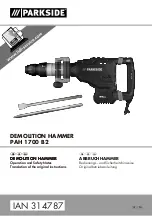
12
MAKE A FEW PRACTICE CUTS
After installing the bit into the tool and
adjusting your depth guide, you should make
a few practice cuts with the tool before
attempting an actual job. A few exercises will
give you the necessary practice to make
clean, professional cuts.
Step 1:
Make certain that the collet nut is
securely tightened before turning the tool on.
Step 2:
Hold the tool firmly and turn the tool
ON to your desired speed.
Step 3:
While holding the tool firmly, insert the
bit into the material at a 90° angle, or 45° for
tile (Fig. 9). (You can plunge at 90° in drywall.)
Step 4:
Slowly plunge the bit to a 90° angle to
begin the cut (Fig. 10). The base guide should
be flush to the material surface. For all
materials except when cutting around outlet
boxes in drywall, steer the tool in a clockwise
direction with slow, steady pressure to make
the cut.
You can refer to the chart on page 18 to
determine the proper speed, based on the
materi al being worked and the type of
accessory being used. These charts
enable you to select both the correct
acces sory and the optimum speed at a
glance.
The speed of tool is controlled by setting
this dial on the housing.
Settings for Approximate Revolutions.
Switch Setting
Speed Range
2
1
10,000-12,000 RPM
4
1
12,000-14,000 RPM
6
14,000-16,000 RPM
8
16,000-18,000 RPM
10
18,000-20,000 RPM
Needs for Slower Speed
Certain materials, (some plastics and non
ferrous metals, for ex ample) require a relatively
slow speed because at high speed the friction
of the accessory generates heat and may
cause damage to the material.
Higher speeds are better for cutting, routing,
shaping, cutting dadoes or rabbets in wood.
The point to remember is this: Many
applications and accessories in our line will
provide the best performance at full speed, but
for certain materials, applications, and
accessories, you need slower speeds.
To aid you in determining the optimum
operational speed for differ ent materials and
different accessories, we have construct ed a
series of tables that appear in the accessories
section. By referring to these tables, you can
discover the recommended speeds for each
type of accessory. Look these tables over and
become familiar with them.
Ultimately, the best way to determine the
correct speed for work on any material is to
practice for a few minutes on a piece of scrap,
even after referring to the chart. You can
quickly learn that a slower or faster speed is
more effective just by observing what hap pens
as you make a pass or two at different speeds.
When making practice cuts start at the highest
speed to gauge control. Then reduce the
speed slight ly to get the optimum working
speed.
Some rules of thumb in regard to speed:
1. Plastic and other materials that melt at low
temperatures should be cut at low speeds.
2. When sanding, start at a low speed to
guage material removal rate.
3. Wood should be cut at high speed.
4. Aluminum, copper alloys, lead alloys, zinc
alloys and tin may be cut at various speeds,
depending on the type of cutting being
done. Use paraffin or other suitable
lubricant on the cutter to prevent the cut
material from adhering to the cutter teeth.
Increasing the pressure on the tool is not
the answer when it is not performing as you
think it should. If the tool is not cutting as
fast as you think it should, first try changing
the speed of the tool or the accessory.
Do not force the tool, let the tool do the work.
Leaning on the tool does not help and could
slow the tool if the over current protection
threshold is exceeded.
DM 2610010088 02-10:DM 2610010088 02-10 2/26/10 1:02 PM Page 12













































